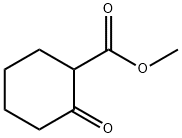Chemical Properties
clear colorless to slightly yellow liquid
Uses
Methyl 2-oxocyclohexanecarboxylate has been used in the synthesis of substituted tetrahydrobenzofuran derivatives via reaction with propargylic esters in the presence of palladium catalyst.
Uses
Methyl 2-Oxocyclohexanecarboxylate is a novel intermediate for the preparation of TRPA1 antagonists for treatment of pain and other TRPA1-associated diseases.
Synthesis Reference(s)
Journal of the American Chemical Society, 102, p. 431, 1980
DOI: 10.1021/ja00521a100Organic Syntheses, Coll. Vol. 7, p. 351, 1990
Synthesis
The flask is flushed with nitrogen and charged with 18.02 g (0.20 mol) of dimethyl carbonate, 50 mL of anhydrous tetrahydrofuran, and 6.12 g (0.25 mol) of sodium hydride. The suspension is stirred and heated to reflux temperature, at which time the slow, dropwise addition of 7.80 g (0.080 mol) of cyclohexanone in 20 mL of dry tetrahydrofuran is begun. After 2 min, 0.306 g (0.0076 mol) of powdered potassium hydride is added to initiate the reaction. The addition of cyclohexanone is continued over a 1-hr period. The mixture is stirred and heated at reflux for another 30 min, cooled in an ice bath for 15–20 min, and hydrolyzed by slowly adding 75 mL of 3 M aqueous acetic acid. The flask's contents are poured into 100 mL of aqueous sodium chloride, and the aqueous mixture is extracted with four 150-mL portions of chloroform. The organic layers are combined, dried with anhydrous sodium sulfate, and concentrated at room temperature with a rotary evaporator. Distillation of the residual liquid under reduced pressure gives 9.8–10.8 g (79–87%) of methyl 2-oxocyclohexanecarboxylate as a colorless liquid, bp 53–55°C.



